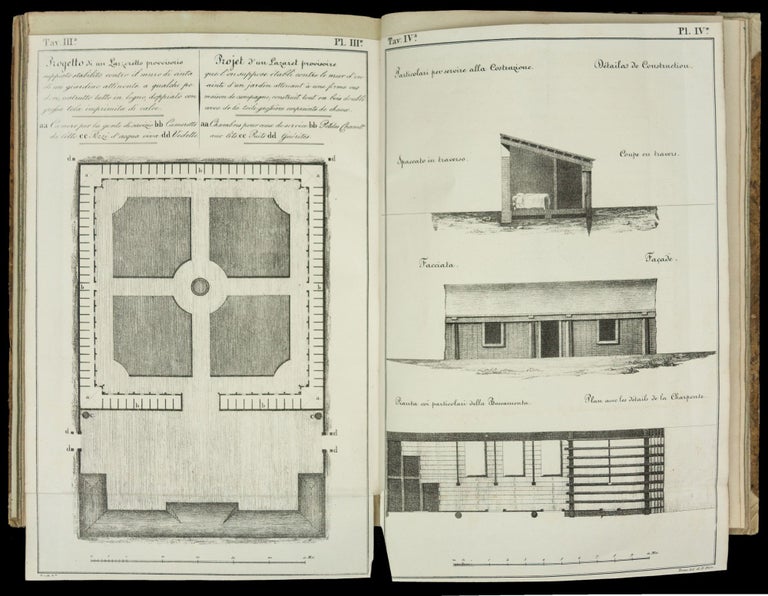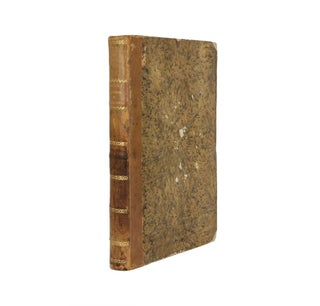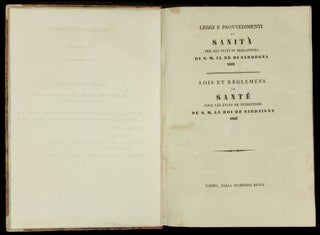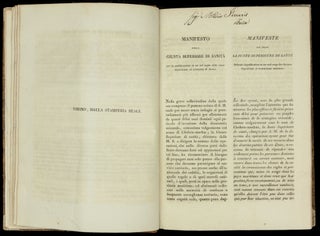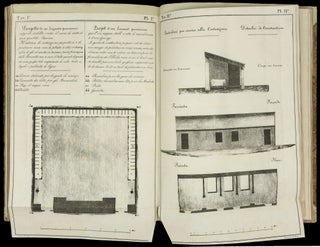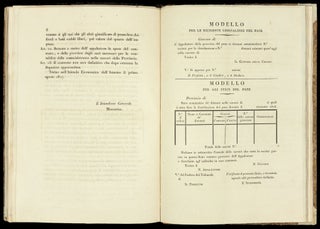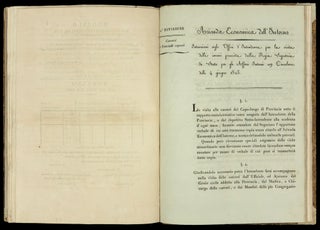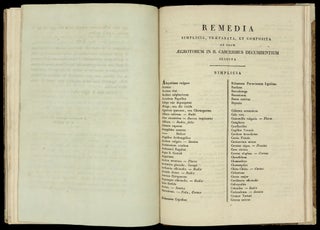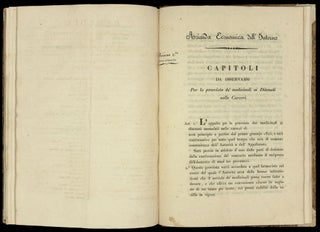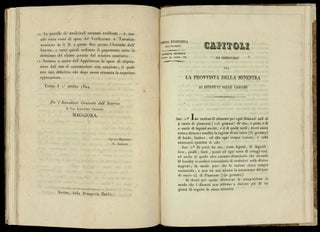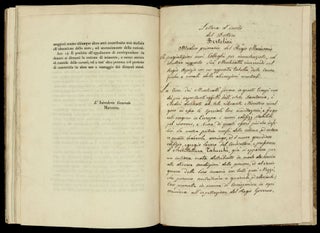Leggi e provvedimenti di sanità per gli stati di terraferma di S. M. il Re di Sardegna 1831 / Lois et réglemens e santé pour les états de terreferme de S. M. le Roi de Sardaigne 1831.
4to [28.1 x 19.8 cm], (110) ff. (6 of which are integral blanks), (1) f. errata loosely inserted, with IV folding lithograph illustrations (by D. Festa after the designs of Berutto). The volume contains a further 6 letterpress documents and 2 manuscript items dating from 1823-30, concerning the medical dimensions of prison administration in northern Italy, totaling 62 pages (see below for full contents and collations). Half bound in contemporary tan calf and tree-calf paper over pasteboards, vellum tips, gold-tooled spine, title (“Colera, Carceri, e Manicomio”) gold-stamped on spine, blue sprinkled edges. Some scuffing and edge wear to spine and boards, a few contemporary annotations to the letterpress items, the occasional very minor stain, contemporary address/signature of Dr. Giambattista Ferraris of Biella on a few leaves. Extraordinary compendium of very rare, official letterpress documents (several of which are unrecorded and none of which is held in U.S. collections) and manuscript items collected during the 1820s and early 1830s by Giambattista Ferraris (fl. 1820’s -30’s), a prison doctor in the northern Italian town of Biella. The volume provides a valuable glimpse into the professional preoccupations and duties of prison physicians at the time, including special rules for administering drugs, regulating the nourishment of prisoners, tending to the mentally ill, and, crucially, preventing and treating infectious diseases, principally cholera. The first and most substantial text in the volume is an official document, more than 200 pages in length, establishing laws and protocols for the Stati Sardi di Terraferma (the region around Torino) to combat what would come to be called the ‘Second Cholera Pandemic’ (1826-37), also known as the ‘Asiatic Cholera Pandemic,’ which was then threatening Europe. This bilingual Italian-French document, issued by the Giunta Superiore di Sanità, is today known only in a handful of Italian institutional collections (according to OCLC, KVK, OPAC) and is an important witness to the drastic public-health measures adopted to treat cholera and halt its spread. Discussed in detail, in 19 chapters, are the nature of the disease, quarantining the afflicted and disinfecting their possessions, measures for avoiding becoming ill, best practices for policing and maintaining cordons (the perimeter of quarantined areas, both large and small). etc. Of special note are 4 fine lithographs showing how preexisting farmhouses and walled gardens could be quickly converted into lazzaretti, or cells for quarantining the sick (plans, profiles, sections, and details of carpentry are illustrated, full budgets are provided). Highly interesting is also the series of sample probing questions to be asked during interrogations of the potentially afflicted seeking entry into quarantined areas. The cholera pandemic, which would claim hundreds of thousands of lives, spread west from Moscow in August 1830, reaching Warsaw in the summer of 1831. The regulations and directives presented here were established in October 1831 and apparently printed in great haste, with individual chapters distributed to relevant authorities as they came off the press: In the copy at hand, for example, each chapter was folded and addressed to Doctor Ferraris in Biella (only later did he bind them together), who no doubt would have been on guard against the visitation of cholera among his inmates. The second item in the volume is an even earlier public-health document concerning the Second Cholera Pandemic. Dated 18 November 1830 and signed by the Capo del Magistrato del Protomedicato in Chiesa, it outlines the spread of the disease from the Far East, suggests steps to halt cholera’s progress, describes symptoms in detail, and discusses etiology, cures and prevention measures. OCLC and KVK locate no examples this imprint; another version of the tract, printed in Trento, is recorded in a few copies in Italy, but nowhere else. The remaining letterpress documents in the compendium date from the 1820s and deal with the medical dimensions of incarceration under more typical conditions (see below for full contents and collations). Included are (item 3) rules for providing prisoners with bread (rations for the infirm and the well, recipes, and a model form to be used in making official requests for bread); (item 7) rules for providing inmates with soup (recipes measured to the gram, licit and illicit vegetables, administration, costs, etc.); (item 5) an extensive list in Latin of some 500 drugs and medical preparations for use in prisons; (item 6) rules for the supply and administration of drugs in prisons; and (item 4) a checklist for monthly prison inspections to be made by the Intendente, who was often to be accompanied by the doctor, surgeon or other officials. None of these documents are recorded in institutional collections (OCLC, KVK, OPAC). At the end of the volume is an extraordinary manuscript item suggesting that Dr. Ferraris also attended to mentally ill prisoners in his care. The work is a copy, presumably written out by Dr. Ferraris, of an 1830 address to colleagues made by Dr. Cipriano Bertolini, newly appointed head of Torino’s mental hospital (Regio Manicomio), concerning the physical and moral causes of madness. Bertolini mentions the architect of the asylum, Giuseppe Talucchi (1782-1863), before discussing debates about the origins of insanity. He then lists 33 potential physical causes of madness (hereditary condition, alcoholism, head injury, mercury exposure, masturbation, menstruation, pregnancy, etc.). No less fascinating are his potential moral causes, which include reversals of fortune, overindulgence in politics, maleducation and a dissolute lifestyle, too much study without exercise, deep thinking on astrological, metaphysical and mystical matters, and even reading novels (La lettura dei Romanzi). The success of ‘moral’ treatments for madness had by the early 19th century cast doubt on the bodily approach of physicians, but by the middle century many doctors argued that the insane often had both ‘moral’ and physical/organic problems. This claim was an important step in the medical profession’s eventual success in securing a monopoly on the treatment of insanity (over, for example, the interventions of religious authorities). Bertolini later published Prospetto statistico-clinico-psichiatrico con classificazione dei ricoverati nel R.manicomio di Torino (1832) but it does not contain the moral-physical causes of insanity listed here, and this short address was apparently never published. The volume closes with a 2-page manuscript item touching on more mundane topics, namely prison fees and laundry service, etc. Full contents and collation: 1. Leggi e provvedimenti di sanità per gli stati di terraferma di S. M. il Re di Sardegna 1831 / Lois et réglemens e santé pour les états de terreferme de S. M. le Roi de Sardaigne 1831. Torino, Dalla Stamperia Reale, [1831]. (110) ff. (6 of which are integral blanks), (1) f. errata loosely inserted, with IV folding lithograph illustrations. 2. Istruzione ad uso delle Autorità sanitarie e del personale addetto agli Stabilimenti di contumacia, onde preservare i confini degl’ II. RR. Stati Austriaci dalla irruzione del Cholera morbus epidemico, che regna nell’Impero delle Russie, ed impedirne la propagazione nel non impossibile caso che potesse penetrarvi. Torino, Dalla Stamperia Reale, [1830]. 24 pp. (pp. 12-23 titled Trattato medico sopra il cholera morbus). Signed at end “V. Il Capo del Magistrato del Protomedicato, Chiesa.” 3. Capitoli da osservarsi per la provvista del pane ai carcerati. 6 pp., (1) f. “Modello” bread request form. Attribution on first page reads “Azienda Economico dell’ Interno, Divisione 2.da, Carceri, ed Opere Pie,” signed at end “L’Intendente Generale, Maggiora,” Torino, 1 August 1827. No copies recorded (OCLC, KVK, OPAC). 4. Azienda Economico dell’Interno. Istruzioni agli Offizi d’Intendenza per la visita delle carceri prescritta dalla Regia Segretaria di Stato per gli Affari Interni con Circolare delli 4 giugno 1823. (4) pp. Attribution on first page reads “2.a Divisione, Carceri e Fanciulli esposti,” signed at end “L’Intendente Generale dell’Interno, G. M. Caccia,” Torino, 8 July 1823. No copies recorded (OCLC, KVK, OPAC). 5. Remedia simplicia, praeparata, et composita ad usum aegrotorum in R. Carceribus decumbentium selecta. 6 pp., (1) f. integral blank. Signed at end “Dall’ Azienda Economica dell’ Interno li 10 gennajo 1825. Per copia conforme, Il Primo Segretaro G.e Anselmi.” No copies recorded (OCLC, KVK, OPAC). This list is reproduced in Raccolta di regi editti, proclami, manifesti ed altri provvedimenti de’ magistrate ed Uffizi, vol. 23 (1825), pp. 59-63 6. Azienda Economica dell’ Interno. Capitoli da osservarsi per la provvista de’ medicinali ai Ditenuti nelle Carceri. Torino, dalla Stampa Reale, [1824]. (2) ff. Attribution on first page reads “Divisione 2.da, Carceri ed Opere Pie,” signed at end “Per l’Intendente Generale dell’ Interno, Il Vice Intendente Generale, Maggiora; Il primo Segretario, G. Anselmi,” Torino, 1 October 1824. No copies recorded (OCLC, KVK, OPAC). 7. Capitoli da osservarsi per la provvista della minestra ai ditenuti nelle carceri. (2) ff. Attribution on first page reads “Azienda Economica dell’ Interno, Divisione Seconda, Carceri ed Opere Pie,” signed at end L’Intendente Generale, Maggiora,” no date. No copies recorded (OCLC, KVK, OPAC). 8. BERTOLINI, Cipriano. Lettera d’invito del Dottore Bertolini, Medio primario del Regio Manicomio. Tavola delle cause fisiche delle alienazione mentali. Tavola delle cause morali. (4) ff. manuscript. Dated from Torino, 6 November 1830. 9. Cattegoria di Penzione, e Regolamento spettanti alle medesime nell’Interno del Regio Manicomio. (1) f., (1) f. integral blank. Unsigned, no date. * Calendario generale pe’ Regii Stati, vol. 9 (1832), p. 291.

